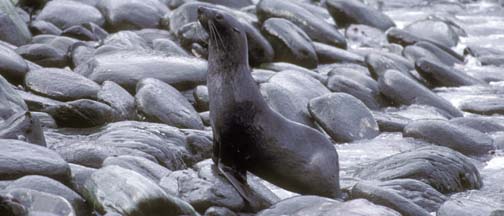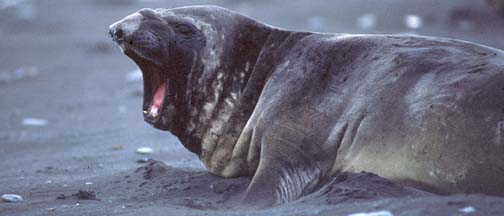
(Click on any image below to link to a larger picture.)
 Antarctic Fur Seals have staked out many
locations in the Chinstrap Penguin rookery on Cape Lookout.
Antarctic Fur Seals have staked out many
locations in the Chinstrap Penguin rookery on Cape Lookout.
 This seal carefully checks out the beach as it
climbs out of the water.
This seal carefully checks out the beach as it
climbs out of the water.
 Antarctic Fur Seals have external ear flaps,
called pinnae, like those on California Sea Lions.
Antarctic Fur Seals have external ear flaps,
called pinnae, like those on California Sea Lions.
 Antarctic Fur Seals have retained greater
function in their rear limbs than the true seals. This allows
them to walk, run, and climb rocks.
Antarctic Fur Seals have retained greater
function in their rear limbs than the true seals. This allows
them to walk, run, and climb rocks.
 Antarctic Fur Seals can use their tail fins to
scratch their itches.
Antarctic Fur Seals can use their tail fins to
scratch their itches.
 Adolescent male Fur Seals engage in
some roughhousing.
Adolescent male Fur Seals engage in
some roughhousing.
 Fur Seals at rest on abandoned
whale oil barrels at Whaler's Bay.
Fur Seals at rest on abandoned
whale oil barrels at Whaler's Bay.
Link to information about the Antarctic Fur Seal at Antarctic Adventure.
Jaap van der Toorn has created a page describing the various Fur Seals.
 A Weddell Seal lying on an ice floe in the
Weddell Sea. Weddell Seals are "true seals". They have
no external ear flaps and their hind limbs are more adapted for
swimming and less useful for propulsion on land or ice. They are
gray with spots.
A Weddell Seal lying on an ice floe in the
Weddell Sea. Weddell Seals are "true seals". They have
no external ear flaps and their hind limbs are more adapted for
swimming and less useful for propulsion on land or ice. They are
gray with spots.
 A pair of Weddell Seals cruise slowly past Kelp Gulls along the
shoreline of Neko Harbor in Andvord Bay.
A pair of Weddell Seals cruise slowly past Kelp Gulls along the
shoreline of Neko Harbor in Andvord Bay.
 A solitary Weddell Seal basking on the beach at
Whaler's Bay, where it is warmed by geothermal heat.
A solitary Weddell Seal basking on the beach at
Whaler's Bay, where it is warmed by geothermal heat.
 Weddell Seal scratching its tail flipper with a
pectoral fin.
Weddell Seal scratching its tail flipper with a
pectoral fin.
Link to information about the Weddell Seal at Antarctic Adventure.
Link to information about the Weddell Seal from the Sierra Club Handbook of Seals and Sirenians.
 Ice Floes are very popular with Crabeater Seals. Crabeater Seals
are the most common seals. Despite their name, crabs do not
constitute the larger portion of their diet. They eat more fish
and squid. Their fur is tan to brown and more uniform in color
than the fur of the Weddell Seal.
Ice Floes are very popular with Crabeater Seals. Crabeater Seals
are the most common seals. Despite their name, crabs do not
constitute the larger portion of their diet. They eat more fish
and squid. Their fur is tan to brown and more uniform in color
than the fur of the Weddell Seal.
 This pair of Crabeater Seals was taking shelter behind a low ice
ridge.
This pair of Crabeater Seals was taking shelter behind a low ice
ridge.
 Crabeater Seals lay about on the ice in large groups.
Crabeater Seals lay about on the ice in large groups.
 This Crabeater Seal appears to have just eaten
a very bloody meal.
This Crabeater Seal appears to have just eaten
a very bloody meal.
Link to information about the Crabeater Seal at Antarctic Adventure.
Link to information about the Crabeater Seal from the Sierra Club Handbook of Seals and Sirenians.
 Southern Elephant Seals share Cape Lookout with several species
of penguins, including the Gentoo Penguin seen here. The rear
limbs of "true seals" are of relatively limited
usefulness for moving about on land.
Southern Elephant Seals share Cape Lookout with several species
of penguins, including the Gentoo Penguin seen here. The rear
limbs of "true seals" are of relatively limited
usefulness for moving about on land.
 This Southern Elephant Seal is molting. Old fur is falling out in
patches to be replaced with a new coat.
This Southern Elephant Seal is molting. Old fur is falling out in
patches to be replaced with a new coat.
 Southern Elephant Seals bask on the rocky shore
below Hannah Point. Most of them are adult females. There are a
few juveniles of both sexes as well.
Southern Elephant Seals bask on the rocky shore
below Hannah Point. Most of them are adult females. There are a
few juveniles of both sexes as well.
 Female Southern Elephant Seal.
Female Southern Elephant Seal.
 A large male Southern Elephant Seal is lying on
the beach just beyond this trio of female Southern Elephant
Seals. The Southern Elephant Seal is the largest species of seal.
A large male Southern Elephant Seal is lying on
the beach just beyond this trio of female Southern Elephant
Seals. The Southern Elephant Seal is the largest species of seal.
 A trio of juvenile seals lying on the cobbles
above the beach. They are lighter in color than the adult seals.
A trio of juvenile seals lying on the cobbles
above the beach. They are lighter in color than the adult seals.
 The male Southern Elephant Seal is much larger
than the female. Male Southern Elephant Seals do not have as much
of a trunk-like proboscis as the Northern Elephant Seal.
The male Southern Elephant Seal is much larger
than the female. Male Southern Elephant Seals do not have as much
of a trunk-like proboscis as the Northern Elephant Seal.
Link to information about the Southern Elephant Seal at Antarctic Adventure.
Link to information about the Southern Elephant Seal from the Sierra Club Handbook of Seals and Sirenians.
You can buy a 2020 Calendar featuring my photographs of seals taken in Antarctica.
A dozen photos of seals in Antarctica. Seals pictured include:
Antarctic Fur
Weddel
Crabeater
Southern Elephant.
Locations include:
Cape Lookout on Elephant Island
Deception island
Livingstone Island
Antarctic Sound.
 Put a copy of the Antarctic Seals 2020 Calendar in your Lulu.com shopping cart for $14.95.
Put a copy of the Antarctic Seals 2020 Calendar in your Lulu.com shopping cart for $14.95.